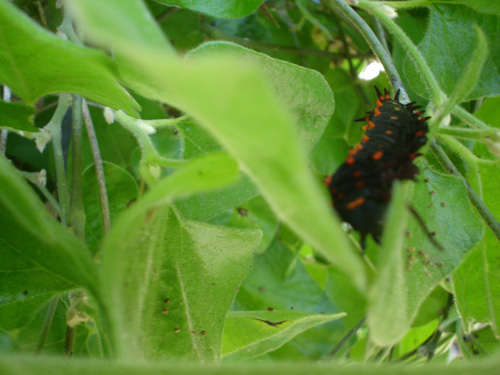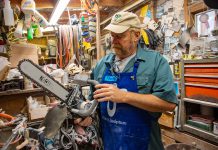
It was a 4th grade lesson on birds and flowers at Oak Grove School in the 1920’s that ignited Louise Hallberg’s passion for science and nature. It seems to be the winged one’s she’s most fond of, earning her the nickname, “The Butterfly Lady.”
“I don’t know much, but I know a lot more than I did,” said Hallberg about her butterfly expertise. In 1975 that she began studying and researching butterflies and building the butterfly garden and in 1997 Hallberg Butterfly Garden became a non-profit organization.
Today the humble woman of 96 years lives in Graton and her property, Hallberg Butterfly Gardens and it’s surrounding acreage is a wildlife preserve; a haven for butterflies but also foxes, deer, bees, birds and more. One hundred thirty acres of choice land is filled with lush vegetation, plenty of California native plants but non-natives as well, all planted with a specific purpose in mind; to attract butterflies.
“More than 30,000 people have gone through here, and I often think, what would my parents think,” said Hallberg who lives on the same property that her folks once did. What used to be a grazing pasture for cattle is now a meadow for butterflies.
Next to her front door is a green vine, growing prolifically, and the specimen that marks the birth of the butterfly garden. It wasn’t planted by Louise though but rather her mother. Della Hallberg dug up “the Dutchman’s Pipevine,” off the side of a country road and added it to the homestead landscaping 80 or so years ago.
There’s no doubt that Hallberg was influenced by the actions of both her parents, her mother was an avid gardener and her father diligently recorded the weather for about 30 years, a tradition that Hallberg continues today. Louise Hallberg has been keeping records for the National Weather Service for 45 years, hoping that her data will contribute to further understanding of the way climate affects insects and plants.
Temperature and rainfall can have a huge impact on caterpillars and butterflies that are cold-blooded and need the warmth of the sun for movement. “A rainy April or May makes it hard for the caterpillars to get started,” said docent and volunteer coordinator, Leah Brorstrom. This year, warm temperatures in early spring created a hospitable environment for the Pipevine Swallowtails in the Hallberg garden. A few weeks ago about a dozen of the dramatic black and orange caterpillars were chomping away at the leaves of the pipevine and six chrysalises have been spotted and documented.
“You see, there is a host plant for each butterfly,” said Hallberg who went on to explain, “the Pipevine Swallowtail needs the pipevine, for food and to lay eggs, the Monarch needs milkweed, stinging nettle is for the Red Admiral”
Some butterfly species need water or mud, others need shelter from wind, or one plant for caterpillar food and another for laying eggs as well as many plants for nectaring.
To make matters just a little more complicated, many of the plants that butterflies require for food and reproduction are considered weeds, and routinely yanked or eradicated with herbicides from properties throughout Sonoma County. “Here we try to leave the weeds. Some are not impressed, and that’s ok,” said Hallberg.
The non-profit has been documenting butterfly sightings for 20 years now. “Since about the year 2000, butterfly sightings of many species has decreased,” said Brorstrom who has been giving tours of the garden for more than five years.
Wide open meadows with tall grasses and wildflowers are important for butterflies and spaces like that can be hard to find these days in some parts of the county that are covered with a plethora of asphalt, sidewalks and large buildings.
“It’s all about taking care of the Earth, and how precious life is,” said Oak Grove Elementary School third grade teacher, Peggy Heil, about Hallberg Butterfly Gardens. “Life is such a delicate balance and butterflies show that life is fragile,” she added.
Brorstrom believes that habitat change/loss in Sonoma County is a leading reason for lower butterfly populations, and noted that orchard to vineyard conversions have played a role. “Apple trees flower and blossom attracting pollinators, but vineyards are wind pollinated,” said Brorstrom.
A Gravenstein apple orchard, planted in 1948 is part of the butterfly habitat at Hallberg’s and the trees provide nectaring apple blossoms for butterfly species such as the Anise, Tiger Swallowtails, and Cabbage White. Sheltering shady leaves protect butterflies and cocoons and rotting fruit serves as a food source.
In order to see butterfly eggs, caterpillars, cocoons and butterflies, plenty of habitat and diversity is needed and that’s what Hallberg aims to provide and share with others. “I know it’s not very big (the butterfly garden) but so many people are so glad they can come here to see what they see,” said Hallberg who offers tours by appointment to schools and the public from April 1 to Oct. 31, Wednesday through Sunday.
Schools throughout Sonoma County come each year to visit one of the oldest butterfly gardens in the United States. Often the kindergarten, first or second grade classes have raised Painted Lady butterflies in the classroom, but the insects are fed special food, and are not observed eating the leaf of a plant in the great outdoors.
“Creating the link between nature and the life cycle is important,” said Brorstrom, who feels that Hallberg Butterfly Gardens is a natural, happy place for kids and adults alike. She speaks from experience. “I was on one of the first school tours in 1989,” said Brorstrom who attended Oak Grove School.
Hallberg Butterfly Gardens 16th annual Open Gardens Celebration
Date: Sunday, June 23
Time: 10 a.m. to 4 p.m.
Online: www.hallbergbutterflygardens.org
By phone: (707) 823-3420
Featuring host and nectar plants for sale, people travel from near and far to purchase obscure butterfly favorites, like Dutchman’s pipevine, milkweeds, salvias, verbenas, scabiosa and Buddleia.
Those attending can also count on a bird information table, wild flower exhibit, insect and host plant information, and books and crafts for sale. Docents will be on hand to answer questions and the gardens will be open for touring.
Children’s activities like creating paper butterflies and face painting will add a little extra stimulation for inquiring minds and busy bodies.
A magnetic board will tally butterfly sightings for the day and refreshments will be available for purchase. Projects completed by Santa Rosa Junior College interns and school age children will be on display.
Last year 1,200 visitors throughout Sonoma County came to the open gardens and 15 butterfly species and 22 different birds were sighted.
About 40 volunteers pitch in to make the open gardens event possible. “Without our volunteers we couldn’t keep going,” said Hallberg who is looking forward to the big day.








